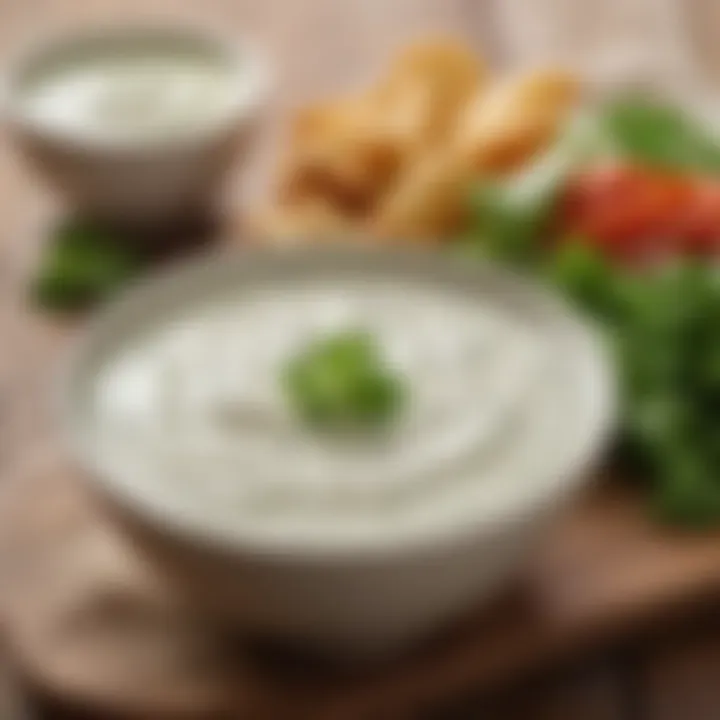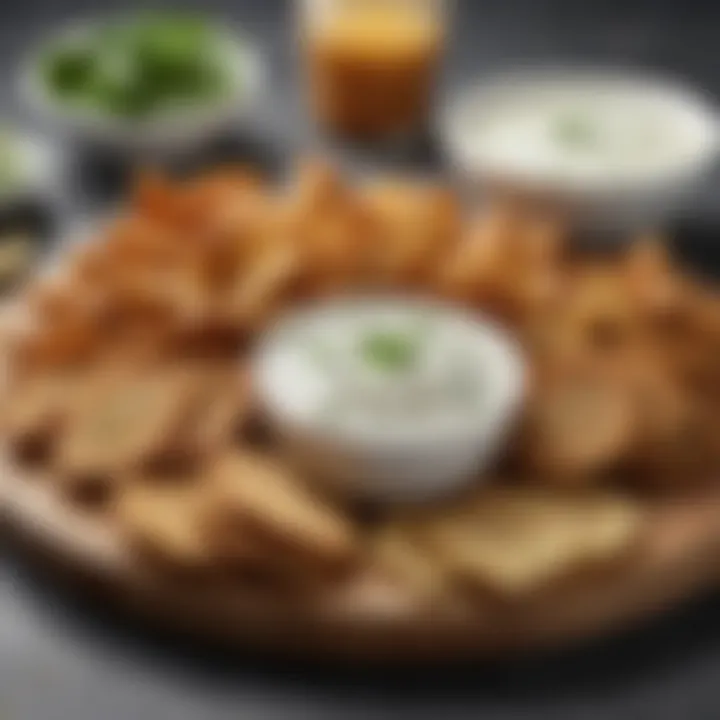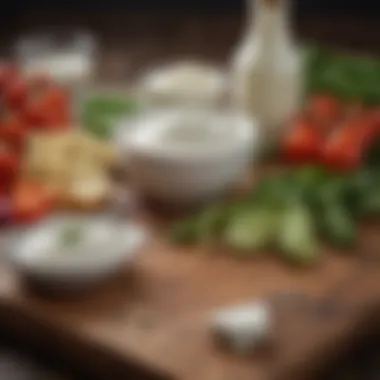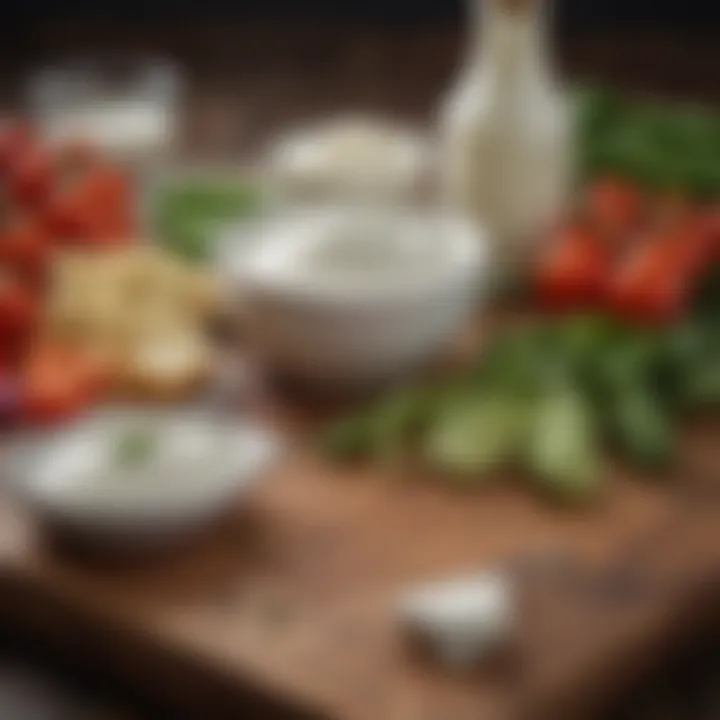Crafting a Perfect Ranch Dressing with Seasoning


Intro
When one thinks of ranch dressing, a wave of nostalgia may wash over them. This creamy, tangy blend has become a staple in American cuisine, often serving as both a salad dressing and a dip. But did you know that the origins of ranch dressing go back to the 1950s? It was created by a rancher named Steve Henson in California, and from there, its popularity skyrocketed. Since then, ranch dressing has evolved, and incorporating ranch seasoning into your own recipe can elevate the flavor profile substantially.
Imagine crafting your own ranch dressing, tailored to your taste buds and using ranch seasoning as a key element. Not only can you control the ingredients, but you can also experiment with different flavors, textures, and variations that reflect your personality in the kitchen. From salads to veggies, ranch dressing finds a place in a myriad of culinary contexts.
As we dive into the intricacies of making ranch dressing with ranch seasoning, we'll explore essential ingredients, offer tips for perfecting the balance of flavors, and even discuss variations that can suit any palate. This guide intends to arm culinary enthusiasts with knowledge and creativity, turning an everyday dressing into an exceptional homemade delight.
Let’s get rolling with an overview of this delightful recipe.
Preface to Ranch Dressing
Ranch dressing is more than just a condiment; it’s an integral part of American cuisine. Born from humble beginnings, this creamy delight has transcended its role from a simple salad dressing to a beloved dip and flavor enhancer for various dishes. Its versatility is unmatched, making it a staple in households across the nation.
Whether you're dolloping it on crisp salads, drizzling over grilled vegetables, or using it as a dip for fresh-cut veggies, ranch dressing has become a culinary must-have. But how did this iconic dressing gain such a foothold in American kitchens? The journey of ranch dressing is truly fascinating and demands exploration.
Historical Background
The origins of ranch dressing trace back to the 1950s. It was first created by Steve Henson, a plumber who moved to California and developed the recipe while working in a dressing industry. In 1954, he opened Hidden Valley Ranch, a dude ranch that had guests clamoring for his delicious dressing. With its distinct blend of buttermilk, herbs, and spices, ranch dressing became a hit, leading to its commercial production and countless variations.
By the 1980s, ranch dressing had exploded in popularity, becoming the top-selling dressing in the United States, overtaking others like Italian and blue cheese. The creamy texture and zesty flavor made it appealing to both kids and adults alike. It’s said that ranch dressing is now a part of nearly 10% of all salad dressings sold in America, showcasing its extensive reach.
Cultural Impact
Ranch dressing is not just a flavor; it’s a cultural phenomenon. It embodies a casual dining experience that reflects the American lifestyle. Whether it’s slathered on pizza, served alongside chicken wings, or blended into various dips, ranch dressing resonates with diverse culinary practices accompanying social gatherings, parties, and family dinners.
Ranch dressing also finds itself in the realm of humor and parody. You might have seen memes floating around that depict a passionate love for ranch dressing. These playful takes reflect not just affection for the dressing but its symbolic role in gastronomical identity.
To add to its cultural footprint, ranch flavor has been incorporated into snacks such as potato chips and popcorn, grabbing the attention of snack lovers. The adaptability has opened doors to innovative culinary creations, pushing culinary boundaries while retaining its core essence.
Understanding Ranch Seasoning
Ranch seasoning is the secret sauce behind that creamy, herby goodness that makes ranch dressing so beloved. This segment is not just about what’s thrown into a jar; it’s about understanding the nuances that transform simple ingredients into a flavorful masterpiece. Embracing this knowledge lays the groundwork for crafting an impeccable ranch dressing that can elevate your culinary creations.
Key Ingredients
The backbone of ranch seasoning typically includes a blend of dried herbs and spices. Here’s a breakdown of what you might find:
- Buttermilk powder: This adds a creamy tanginess reminiscent of traditional ranch dressing, imparting a rich mouthfeel.
- Garlic powder: A staple in seasoning blends, it brings depth and aroma that dances on the palate.
- Onion powder: This rounds out the flavor profile with its slightly sweet and savory notes, providing that all-important umami.
- Dill weed: Often a signature herb in ranch flavor, it contributes a fresh, grassy essence that brightens the mix.
- Paprika: Adding a hint of color and a smokiness that can elevate the overall flavor.
When you mix these elements together, you create a base that not only enhances ranch dressing but can also kick up the flavor in dips, marinades, and salad dressings. It’s a versatile mix that works wonders on various dishes.
Flavor Profile
The flavor profile of ranch seasoning can be described as creamy, tangy, and herbaceous. It plays a significant role in the overall experience of ranch dressing. Think of a summer picnic and how this dressing often finds its way to salads and veggie platters. The combination of rich buttermilk paired with aromatic spices teases the taste buds, dancing between cool and zesty.
Here’s a look at some of the key flavor attributes:
- Creamy and Tangy: Buttermilk powder plays a crucial role in providing that classic ranch experience.
- Earthy and Herbal: Ingredients like dill and parsley give freshness, reminiscent of a spring garden.
- Mildly Spicy: A touch of black pepper and paprika offers warmth without overwhelming, striking a balance perfect for dipping or dressing.
Understanding this flavor profile helps you appreciate how customizing it with additional spices or herbs can elevate your ranch dressing recipe from standard to outstanding.
Health Considerations
While ranch dressing gets a bad rap sometimes, it’s essential to dig deeper into its ingredients. When made from scratch using ranch seasoning, you have control over what goes in, which can lead to healthier options without sacrificing on taste. Here are some considerations:


- Portion Control: Ranch dressing can be calorie-dense. Opting for homemade versions allows you to modulate your serving size.
- Opting for Greek Yogurt: Substituting sour cream with Greek yogurt can help reduce fat content and boost protein, making it a lighter choice.
- Fresh Veggies: Using ranch as a dip for fresh veggies not only makes them taste better but adds important nutrients to your diet.
By choosing high-quality ingredients for your ranch seasoning, you can enjoy the beloved flavor while keeping an eye on the nutritional aspects.
In summary, understanding ranch seasoning is critical for anyone who wants to master ranch dressing. Whether it’s the essential ingredients forming the blend, the complex flavor profile that makes it so enticing, or the health considerations, grasping these concepts sets the stage for a delicious homemade ranch dressing that you can customize to your liking.
Basic Ranch Dressing Recipe
When it comes to making ranch dressing, understanding the basic recipe is like knowing the ABCs of cooking. This foundational aspect ensures that any ranch dressing you whip up not only delights the taste buds but also serves as a versatile addition to a variety of dishes. Getting this right opens up a world of culinary possibilities, providing a tangy, flavorful dressing that enhances meals, from salads to grilled meats.
Ingredient List
Crafting your own ranch dressing from scratch might seem daunting, but fear not. The list of ingredients is quite straightforward. Here’s what you’ll need to gather:
- Ranch seasoning mix: The star of the show, providing that classic ranch flavor. You can either buy a pre-made blend or create your own using a mix of herbs and spices, like dried dill, chives, garlic powder, and onion powder.
- Sour cream: This adds a thick, creamy base that’s essential for that rich texture.
- Mayonnaise: It balances out the tanginess of the sour cream and gives a smooth consistency.
- Buttermilk: To thin the dressing to your desired consistency while adding a slightly tangy flavor.
- Fresh herbs (optional): Adding a sprinkle of fresh dill or chives can elevate the flavor.
- Salt and pepper: For seasoning, of course.
Remember, the quality of your ingredients affects the final product. Opt for the freshest herbs and dairy available to make your ranch dressing sing.
Preparation Steps
Once you have your ingredients ready, the process of making ranch dressing is surprisingly simple. Follow these steps:
- Combine the base: In a medium mixing bowl, combine 1 cup of sour cream and 1/2 cup of mayonnaise. Stir them together until they blend into a smooth mixture.
- Incorporate the seasoning: Add 2 tablespoons of ranch seasoning mix to the base. If you’re feeling a touch adventurous, toss in some finely chopped fresh herbs, too.
- Adjust the consistency: Gradually pour in about 1/2 cup of buttermilk, adjusting more or less to achieve your desired thickness. Whisk until everything is well combined.
- Season to taste: Finally, sprinkle in salt and fresh black pepper. Taste and adjust if necessary. Remember, it’s easier to add than subtract—so go easy on the salt.
- Let it rest: For best flavor, cover your dressing and let it chill in the refrigerator for at least 30 minutes before serving. This step allows the flavors to meld beautifully.
The secret to a great ranch dressing often lies in the resting time. Allowing those flavors to marry will enhance the overall experience.
With just these simple steps, you can have your homemade ranch dressing ready to complement your favorite meals. Now, you're set to enjoy a delicious, creamy dressing that brings a touch of nostalgia, alongside versatility that suits any occasion.
Variations of Ranch Dressing
When it comes to ranch dressing, variety might just be the spice of life. The classic ranch flavor is a canvas, easily adaptable to suit a multitude of palates and occasions. Embracing variations not only spices up your meals but also allows you to cater to diverse dietary needs and preferences. From subtly herbed options to fiery interpretations, each variation offers a fresh take on the beloved dressing, making it a versatile addition to your kitchen.
Herbed Variations
Herbed variants of ranch dressing elevate the sensory experience. Adding fresh or dried herbs can introduce complex flavors that transform the basic ranch dressing. Consider incorporating ingredients such as fresh dill, oregano, or thyme. These herbs complement the creamy texture beautifully.
For a delicious herbed ranch, you might start with the classic ranch recipe and enhance it like this:
- 1 cup mayonnaise
- 1 cup sour cream
- 1 tablespoon dried dill
- 1 tablespoon fresh parsley (finely chopped)
- 1 teaspoon garlic powder
Mix all ingredients thoroughly. The result is a herbed delight that pairs well with grilled chicken or fresh salads. These additions not only enhance flavor but also bring visual appeal with their vibrant colors.
Spicy Concoctions
If you crave a little heat, spicy ranch variations can elevate your dishes to new heights. Several options exist to introduce that kick. For a straightforward approach, consider adding a few dashes of hot sauce like Frank's RedHot or Sriracha. Alternatively, you could blend in some crushed red pepper flakes or even diced jalapeños for a fresh flavor.
For a fiery ranch dressing, try:
- 1 cup ranch dressing
- 2 tablespoons Sriracha
- 1 tablespoon lime juice
Just stir them together, and you’ll get a zesty ranch perfect for dipping fresh veggies or drizzling over tacos. Beyond augmenting flavor, spicing it up can transform your ranch from a standard dip to a bold culinary experience, ideal for adventurous palates.
Creamy Alternatives
Some folks might seek a lighter approach or have dietary restrictions. In this case, creamy alternatives to traditional ranch dressing exist. These might include using Greek yogurt instead of mayonnaise for a tangy, protein-packed version. This approach retains that luscious creaminess while offering additional nutrients.
Consider this recipe for a creamy, yogurt-based ranch:


- 1 cup Greek yogurt
- 1/4 cup buttermilk
- 1 tablespoon lemon juice
- 1 teaspoon onion powder
Combine well and adjust the thickness by adding more buttermilk if desired. This variation is not only nutritious but pairs wonderfully with healthier options like fresh carrot sticks or crispy cucumber rounds. You gain the same flavor depth while tailoring the dressing to meet specific dietary needs.
Ranch dressing isn't just a dip; it’s a culinary canvas, waiting for your unique touch!
In summary, exploring the variations of ranch dressing opens doors to new culinary adventures. With so many substitutes and enhancements, your ranch can adapt to suit any table, making it a perennial favorite for gatherings or simple weeknight dinners.
Practical Cooking Tips
When it comes to crafting a homemade ranch dressing with ranch seasoning, practical cooking tips can make all the difference. These tips not only streamline the process but also enhance the overall quality of the dressing. Understanding how to layer flavors, assess consistency, and handle ingredients thoughtfully ensures a delicious outcome every time. Plus, having a few tricks up your sleeve can impress friends and family alike.
Mixing Techniques
Mixing is vital, and how you achieve that can affect the flavor and texture of your ranch dressing. Here are some effective techniques to consider:
- Start with a Whisk: Using a whisk to combine your ingredients can create a light and airy texture. This is particularly useful for blending the ranch seasoning with your base ingredients like sour cream or yogurt.
- Mason Jar Method: An underrated approach is shaking all the ingredients in a mason jar. This not only combines them thoroughly, but it's also a fun way to mix it up! Just make sure the lid is on tight.
- Blender Use: For those who enjoy a really smooth dressing, throwing it all in a blender can do wonders. Just be careful not to over-blend; a few pulses should suffice, or you may end up with a sauce rather than a dressing.
These techniques not only ensure the consistency of your ranch but also enhance its flavor as the ingredients intertwine. Whether you prefer a chunky dressing bursting with herbs or a creamy one that pours easily, your mixing technique will help you achieve that balance.
Storage Recommendations
Once you've crafted the perfect ranch dressing, storing it correctly becomes essential. Proper storage preserves the flavors and prolongs the shelf life. Here are some recommendations:
- Refrigerate Promptly: Always store your dressing in the refrigerator right after making it. Not only does this keep it fresh, but it also helps the flavors meld together.
- Use Airtight Containers: Opt for a clean, airtight container to minimize exposure to air, which can cause spoilage. Glass jars work well here, but plastic containers are also suitable.
- Label and Date: It's a simple yet effective practice – label your container with the date it was made. Homemade ranch dressing usually lasts about 5-7 days in the refrigerator. This eliminates guesswork on when to toss it.
Freshness is key. If your ranch dressing starts to separate or develop an off smell, it’s better to be safe and not serve it.
By following these storage tips, you ensure each drizzling, dipping, or dressing moment is as delightful as the first, keeping disappointment at bay on taco nights or salad lunches.
Nutritional Aspects of Ranch Dressing
Ranch dressing is more than just a delicious dip or salad topping; understanding its nutritional elements can lead to smarter choices in your culinary adventures. For those who are health-conscious, the nutritional profile of ranch dressing might raise some eyebrows. It’s vital to dissect this topic because it affects not only your waistline but also your overall well-being. Armed with knowledge about ranch's nutritional content, including calorie counts and healthier alternatives, you can indulge without regrets and keep it balanced.
Caloric Breakdown
The caloric breakdown of ranch dressing often catches many by surprise. A standard serving, which is about two tablespoons, typically contains anywhere from 120 to 150 calories depending on the specific recipe and brand. The breakdown generally looks something like this:
- Fat: About 14 grams, mostly from the oil and dairy components.
- Carbohydrates: Roughly 2 grams, primarily from added sugars and thickening agents.
- Protein: Around 1 gram, largely from buttermilk or yogurt in the recipe.
"Understanding caloric intake can help you enjoy your favorite dips without overindulging."
While calories are important, they're not the whole picture. If you’re looking at nutrition labels, it’s also crucial to keep an eye on sodium levels, which can be quite high, often exceeding 200 milligrams per serving. High sodium can lead to a number of health issues if consumed in excess, so being mindful is key.
Healthier Substitutions
Fear not! Just because ranch dressing can come with a heavyweight nutritional profile doesn’t mean you have to sacrifice taste for health. There are several ways to craft a lighter version of this classic dressing without losing its signature flavor. Here are some ideas:
- Greek Yogurt: Swap out sour cream or mayonnaise for plain Greek yogurt. This will lower calories and boost protein.
- Low-Fat Milk or Buttermilk: You can use low-fat versions instead of whole milk or cream to reduce the fat content significantly.
- Herbs and Spices: Bulking up on fresh herbs can add flavor without any added calories. Fresh dill, parsley, and chives are excellent additions.
- Vinegar: A splash of vinegar can add zest without the calories that come from excess fats.
Using these substitutions not only cuts calories but adds nutritional value, allowing you to enjoy ranch dressing while still being conscious of your health.
Meal Pairings with Ranch Dressing
Combining ranch dressing with various dishes opens up a world of flavors, enhancing the meal experience significantly. Its unmistakable zest and creaminess act as a bridge, connecting countless culinary profiles. Understanding what pairs well with ranch dressing not only enhances taste but also elevates presentation, making any plate more appetizing. Whether it's crisp greens or hearty proteins, knowing how to pair ranch dressing can elevate a simple meal into something unforgettable.
Salads and Vegetables


Ranch dressing is generally seen as the perfect companion for salads, and it's easy to understand why. The robust flavor can complement and balance the elements from different ingredients, be it tangy tomatoes, crunchy cucumbers, or sharp onions. Here's why ranch dressing shines on greens:
- It adds moisture and richness, helping denser vegetables shine and not feel like a chore to chew through.
- It brings a flavorful contrast to lightly dressed salad greens, providing a satisfying bite.
For a clone of a fresh garden salad, try mixing romaine lettuce, cherry tomatoes, carrot ribbons, and bell pepper slices—all touched generously with ranch. The combination keeps the overall flavor light, making it a fantastic choice for lunch. Additionally, roasting vegetables such as broccoli and carrots and then tossing them with a drizzle of ranch makes for a delightful side dish.
"Ranch dressing is not just a condiment; it's a flavor enhancer that can transport a simple salad into a culinary delight."
Grilled Meats
Ranch dressing and grilled meats can be a match made in culinary heaven. Picture juicy steak, perfectly grilled chicken, or even lamb chops, with ranch dressing accompanying them as a dipping sauce or sauce to drizzle right atop the grilled goodness. Its creamy, herby profile complements the smoky, charred flavors, enriching the dining experience.
When playing with grilled meats, consider the following:
- Chicken Wings: Toss your wings in ranch dressing after grilling for a creamy finish.
- Steak Tacos: A ranch drizzle can cut through the savoriness of grilled steak, adding a layer of creaminess that makes every bite joyous.
- Pork Chops: Create a marinade featuring ranch dressing for an extra layer of flavor before throwing them on the grill. The tenderizing effect of the dressing also helps.
Dipping Essentials
Moving from main dishes to snacks, ranch dressing holds its own as a beloved dipping sauce. Its creamy consistency and robust flavor profile make it a reliable friend for a variety of finger foods. From crispy fried treats to healthy options, ranch dressing can elevate your snacking habits.
Some popular uses for ranch as a dip include:
- Vegetable platters: Carrots, celery, bell peppers, and radishes create a fresh, colorful spread, begging for ranch dressing as their companion.
- Wings and nuggets: A generous bowl of ranch serves as the ultimate dip for crispy wings or chicken nuggets, adding an extra zing that crisps them up.
- Potato Chips: A bit unconventional, but chip connoisseurs know the delight that dipping your favorite potato crisp brings—a crunchy, salty bite with creamy ranch can be surprisingly addicting.
In sum, the possibilities for meal pairings with ranch dressing are nearly endless. Whether you're crafting a fresh salad, grilling tender meats, or enjoying some snacks, ranch dressing can enhance flavors and help bring your dishes together in a delightful way.
The Versatility of Ranch Dressing
Ranch dressing stands out as more than just a simple salad topping; its versatility extends far beyond the confines of a lettuce bowl. The magical concoction of tang and creaminess has embedded itself into various culinary traditions and personal preferences. Whether you’re dressing up a meal or seeking a satisfying dip, ranch dressing holds an esteemed place on dining tables around the world. This section explores its multifaceted applications and the myriad benefits that come with this beloved dressing.
Beyond Salads
While traditionally associated with salads, ranch dressing's capabilities stretch into realms not easily pigeonholed. Consider those lazy nights when you're grilling up a steak or preparing a platter of fresh veggies. Just a dollop of ranch can elevate the simplest of dishes. Here are some scrumptious ways to embrace ranch dressing beyond the green leafy realm:
- Potato Wedges: Toss your crispy potato wedges in ranch after baking. The flavor combination is a surefire way to satisfy any craving.
- Pizza: Drizzling a little ranch on slices can add a unique twist to your pizza experience, especially for those who enjoy dipping.
- Tacos: Instead of conventional salsa, try ranch in your tacos. It can provide a creamy texture that contrasts well with spicy flavors.
- Wraps: A spread of ranch in wraps can bind your ingredients together while adding a flavorful punch.
These examples highlight just how accessible ranch dressing can be. It saves you from the mundane and infuses a delightful layer of flavor into everyday meals.
Use in Sauces and Marinades
One might overlook ranch dressing as a cooking ingredient, but it can be an excellent base for sauces and marinades. This simple dressing can flavor a dish from the first moment of preparation to the last bite. Here are several ways ranch can enhance your cooking experience:
- Marinade for Chicken: Using ranch dressing as a marinade before grilling chicken makes the meat tender and succulent. Just coat the chicken with ranch, let it sit for a couple of hours, and grill as you normally would.
- Dip for Fried Foods: Pour ranch over fried pickles or fried chicken bites. It brings an unexpected creaminess that can counterbalance the crunch.
- Flavor Base for Dips: Combine ranch with sour cream and herbs to create a quick dip for parties. Add a touch of garlic or spinach for an extra boost of flavor.
"Ranch dressing offers an amazing versatility that can turn dish preparations simple but tasty, allowing flavors to meld smoothly."
Through these practical usages highlighted above, ranch dressing proves to be more than a mere condiment; it becomes a staple in diversifying culinary expressions. By including ranch in various recipes, you can appreciate its ability to bind flavors together harmoniously, ultimately transforming ordinary dishes into extraordinary experiences.
Ending
In wrapping up our exploration of crafting the ideal ranch dressing using ranch seasoning, it’s crucial to reflect on the myriad aspects that make this dressing a culinary staple. This article has highlighted not just the mechanics of creating a classic ranch dressing, but also the rich history and cultural relevance that it carries. Through understanding the key ingredients and experimenting with various flavors, one can appreciate how versatile this dressing can be.
Final Thoughts on Homemade Ranch Dressing
When it comes to homemade ranch dressing, the primary benefit lies in the personalized touch it offers. Unlike its store-bought counterparts, making ranch dressing from scratch allows you to control the flavor intensity and the freshness of the ingredients. You can tweak spices, adjust creaminess, or even infuse unique elements like herbs from your garden. The culinary landscape can become a canvas for creativity.
Moreover, there's an undeniable satisfaction in serving a dressing that not only tastes delightful but is also crafted with care. Your friends and family are sure to notice the difference.
Homemade ranch dressing is not just a dip; it’s an expression of your culinary personality.
Let’s not forget the health aspect either. By whipping up your ranch dressing, you can make informed choices regarding the nutritional value of each component, thus ensuring a balance between taste and health. Remember, it’s always worth taking the time to craft something that suits your palate and well-being.
As you embark on your ranch dressing journey, keep these considerations in mind. Embrace the process of experimentation, enjoy the rich textures, and share the results with those around you. Ultimately, crafting a ranch dressing using ranch seasoning is as much about the flavors you evoke, as it is about the joy and community that accompany sharing such a beloved dish.







